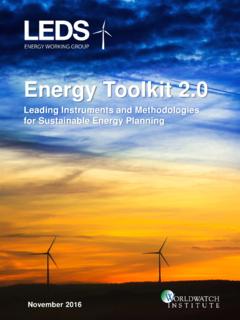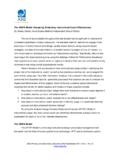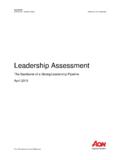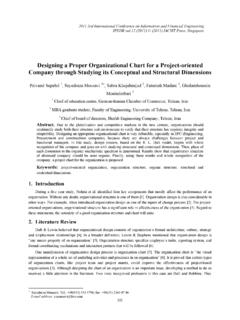Transcription of Caribbean Sustainable Energy Roadmap and Strategy
1 Caribbean Sustainable Energy Roadmapand Strategy (C-SERMS) Baseline Report and AssessmentInter-American Development BankEditor: Lisa Mastny Typesetting and Layout: Lyle RosbothamThe views expressed are those of the authors and do not necessarily represent those of the Worldwatch Institute; of its directors, officers, or staff; or of its funding citation: Alexander Ochs et al., Caribbean Sustainable Energy Roadmap and Strategy (C-SERMS): Baseline Report and assessment (Washington, DC: Worldwatch Institute, 2015)On the cover: Wigton Wind Farm, Jamaica, photo by Mark KonoldAuthors:Alexander Ochs (Project Director)Mark Konold (Project Manager)Katie AuthEvan MusolinoPhilip Killeen Worldwatch Institute, Washington, , 2015 Baseline Report and AssessmentCaribbean Sustainable Energy Roadmap and Strategy (C-SERMS) ContentsAcknowledgments 7 List of Acronyms 8 Executive Summary 101 The Caribbean at an Energy Crossroads Energy and the Regional Context of CARICOM CARICOM Energy Policy Benefits of a Regional Approach to Energy Development in CARICOM The Caribbean Sustainable Energy Roadmap and Strategy (C-SERMS)
2 Methodology and Structure of Report 212 Current Regional Energy Situation Energy Inputs and Outputs Energy Source Matrix Energy Production and Consumption Petroleum Imports and Exports Natural Gas Energy Consumption by Sector Ongoing Developments and Potential Game Changers Electricity Sector Overview Electricity Access Status of Generation, Transmission, and Distribution Systems Electricity Demand Projections Data Gaps Transportation Sector Best Practices in Road Transportation Best Practices in Aviation and Maritime Transportation Data Gaps 512 | C-SERMS Baseline Report and AssessmentContents | Carbon Dioxide Emissions Current Emissions Accounting Future Projections of Emissions from the Power Sector (Business-as-Usual Scenario)
3 Data Gaps 543 Renewable Energy and Energy Efficiency Potential Renewable Energy Potential Modern Biomass Geothermal Hydropower Municipal Solid Waste Ocean Energy Solar Wind Comparative Costs of Renewable Energy Technologies LCOE+ Current Sustainable Energy Initiatives Solar Water Heaters in Barbados Geothermal in Dominica Wind Power in Jamaica Potential of Energy Efficiency in the Region Current Energy Efficiency Initiatives Renewables, Efficiency, and the Grid Regional Interconnection Potential Data Gaps 704 Existing Sustainable Energy Policy Frameworks in CARICOM Member States National Energy Plans and Targets Renewable Energy and Electricity Targets Energy Efficiency Targets Sustainable Transportation Targets Emissions Reduction Targets Policies and Mechanisms Renewable Energy Support Energy Efficiency Support Support for Sustainable Transportation Policy Effectiveness Governance and Administrative Structures Responsible Agencies Data and Information Providers Utilities 854 | C-SERMS Baseline Report and Administrative Procedures Regional Initiatives 875 Setting CARICOM Targets for Renewable Energy , Energy Efficiency.
4 And Greenhouse Gas Emissions Regional Energy Targets Worldwide Recommended Renewable Power Targets for CARICOM Proposed and Agreed Renewable Electricity Targets Methodology Suggested Country Shares An Ambitious Framework for Action on Renewables in Each Member State Methodological Challenges Recommendations for Moving Forward Recommended Energy Efficiency Targets for CARICOM Worldwide Efforts to Reduce Energy Intensity Suggesting Energy Intensity as a Measurement for Energy Efficiency Efforts in CARICOM Member Economies Proposed CARICOM Energy Intensity Target: 33% by 2027 Necessary Policies and Measures Recommended Greenhouse Gas Emissions Reduction Targets for CARICOM The Threat of Climate Change, and Worldwide Mitigation Efforts in the Energy Sector Proposed CO2 Targets for CARICOM Necessary Steps to Achieve Greenhouse Gas Targets 1026 Sustainable Energy for CARICOM.
5 A Strategy to Achieve Regional Targets The Importance of Coordinated Action Between CARICOM and Its Member States A Work Program of Priority Initiatives, Policies, Projects, and Activities (PIPPAs) Addressing Remaining Data and Information Gaps Creating Effective Finance Mechanisms Implementing Policies and Measures Building Regional Capacity Highlighted Priority Areas A Regional Approach to Transportation Regional Energy Trade Agreements The Water- Energy -Food Nexus Greater Coordination of Regional Initiatives Designing National Implementation Plans 124 Endnotes 128 Annex A. CARICOM Member State Energy Capacity Projections and Sectoral Emissions Forecast Annex B. Priority Initiatives, Policies, Projects, and Activities (PIPPAs) for CARICOM Figures, Tables, and SidebarsFigure 1.
6 Major Energy Challenges in the CARICOM Region 18 Figure 2. C-SERMS I Methodology 22 Figure 3. Primary Energy Production and Consumption in CARICOM Member States, 2012 25 Figure 4. Primary Energy Production and Consumption in Trinidad and Tobago, 2002 12 26 Figure 5. Primary Energy Production and Consumption in the CARICOM Region, 2001 12 26 Figure 6. Petroleum Imports in CARICOM Member States, 2006 12 27 Figure 7. Refined Petroleum Imports in CARICOM Member States, 2006 12 29 Figure 8. Refined Petroleum Imports in CARICOM Member States, by Fuel Type, 2012 30 Figure 9. Total Petroleum Exports in CARICOM Member States, 2000 12 31 Figure 10. Refined Petroleum Exports in CARICOM Member States, 2000 12 32 Figure 11. Refined Petroleum Exports in CARICOM Member States, by Fuel Type, 2012 33 Figure 12.
7 Natural Gas Use in Trinidad and Tobago, by Sector, 2014 33 Figure 13. Total Primary Energy Consumption in Selected CARICOM Member States, by Sector, 2014 34 Figure 14. Electricity Access in CARICOM Member States, 2015 37 Figure 15. Population Size versus Electrification Rate in CARICOM Member States, 2012 38 Figure 16. Estimated Technical and Non-Technical Electricity Losses in CARICOM Member States, 2012 43 Figure 17. Residential Electricity Tariffs of CARILEC Members, 2011/12 44 Figure 18. Electricity Generation and Consumption in the CARICOM Region, 2012 and Projections for 2017, 2022, and 2027 44 Figure 19. Net Peak Demand Load Forecast in CARICOM Member States, 2010 27 45 Figure 20. Existing Capacity and Projected Capacity Needs in 2027 for CARICOM Member States 46 Figure 21.
8 Transportation s Share of Total End-Use Energy Consumption in Selected CARICOM Member States, 2014 47 Figure 22. Carbon Dioxide Emissions from Energy Consumption in CARICOM Member States, 2001 12 52 Figure 23. Per Capita Carbon Dioxide Emissions from Energy Consumption in CARICOM Member States, 2012 53 Figure 24. Projected Power Sector Emissions in the CARICOM Region, 2017, 2022, and 2027 53 Figure 25. Global Power Generation Costs by Technology Compared to the Range of Electricity Tariffs in CARICOM Member States 62 Figure 26. Carbon Abatement Cost Curve Analysis for the Dominican Republic 66 Figure 27. Energy Intensity of CARICOM Member States, 2006 12 67 Figure 28. Observed Permitting Processes for Adding Small Hydro Capacity (100 kW to 25 MW) in Jamaica 86 Figure 29.
9 Methodology for Recommending Renewable Power Capacity Targets 90 Figure 30. Achieving Targets Through Coordinated Regional and National Efforts 105 Figure 31. Identified Energy Data and Information Gaps in CARICOM 106 Figure 32. Overview of Transportation Planning in the United States 118 Figure 33. C-SERMS Energy Unit Platform 123 Contents | 56 | C-SERMS Baseline Report and AssessmentTable 1. Selected Indicators of CARICOM Member States 17 Table 2. Petrocaribe Financing Terms 28 Table 3. Installed Power Capacity and Share of Renewables in CARICOM Member States, 2013 and 2015 41 Table 4. Renewable Electricity Installed Capacity in CARICOM Member States 42 Table 5. Potential Average Fuel Economy for New Vehicles, 2005 30 48 Table 6. Renewable Energy Potential in CARICOM Member States 56 Table 7.
10 Status of National Energy Plans in CARICOM Member States 72 Table 8. Renewable Energy and Electricity Targets in CARICOM Member States 74 Table 9. Energy Efficiency Targets in CARICOM Member States, as of 2015 75 Table 10. Sustainable Transportation Targets in CARICOM Member States, as of 2015 76 Table 11. Emissions Reduction Targets in CARICOM Member States, as of 2015 77 Table 12. Renewable Energy Support Policies in CARICOM Member States, as of 2015 78 Table 13. Energy Efficiency Support Policies in CARICOM Member States, as of 2015 81 Table 14. Transportation Policies in CARICOM Member States, as of 2015 82 Table 15. Key Energy Sector Institutions in CARICOM Member States 84 Table 16. Global Renewable Energy Potentials in Different Scenarios 88 Table 17.










